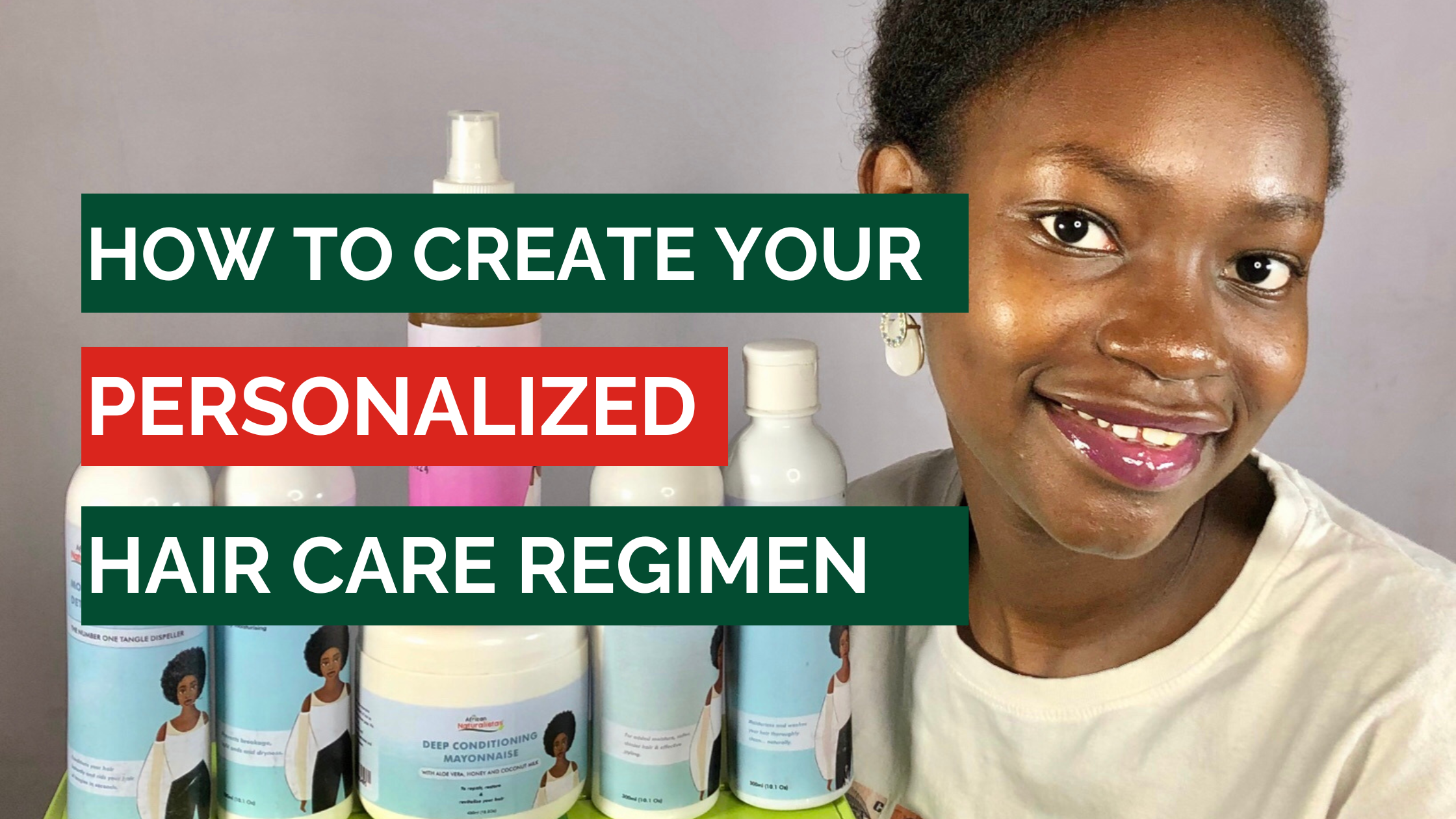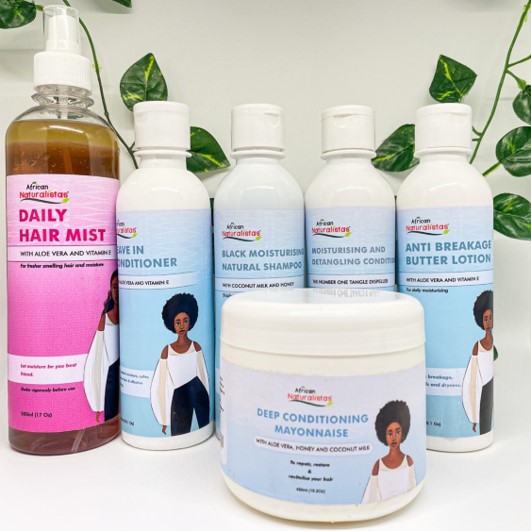One common question that pops up in comment sections of hair influencers and beauty is: “What products did you use ?”, "What's the name of the product ?". And that's because most people think having the perfect hair that turns head is tied to a “magic” hair care product(s).
The truth is that you can have a very good product, but without a hair care regimen that fits your hair type and hair needs, you may find it difficult (and spend longer time) before seeing results with your hair care.
Sometimes all you need to up your hair care game is just a regimen and 1 or 2 products.
That's why in today's post you will see how you can create a personalized hair care regimen that works for you and the four steps you need to follow to create one.
Why Do You Need a Personalized Regimen in the First Place ?
You may be asking yourself: why do I even need a personalized regimen?
Simple answer. Imagine getting a pair of jeans that fits everyone you know irrespective of their size and height.
Not possible, right?
That is what happens with the idea of a one-size-fits-all hair care regimen, which is what most people do when trying to copy exactly what they see hair influencers on TikTok and Instagram doing.
Our hair is as unique as we are, and what works wonders for your friend might leave you nice hair feeling like a tangled mess.
Here are 3 factors that strongly influence the hair care regimen and why you need a personalized regimen:
- Hair Type: Straight hair craves moisture to combat frizz, while curly hair needs products that define curls and prevent dryness. Oily hair benefits from regular cleansing and lightweight products, while dry hair thrives with rich conditioners and deep treatments.
- Hair needs: A healthy scalp is the foundation for healthy hair. For some, a one-size-fits-all shampoo might be too harsh, stripping away natural oils and leading to irritation. A personalized regimen considers your hair's specific needs, be it dryness, itchiness, or even dandruff.
- Goals: A personalized regimen factors in your desired outcome, allowing you to choose products and techniques that help you achieve those goals.
Now that you know the important factors you need to create a personalized hair care regimen, let's look at the steps involved.
Step 1: Understand Your Hair Type
Understanding your hair type is the first crucial step in creating a personalized hair care regimen. Your hair type will fall into one of the generally categorized four main groups:

- Straight Hair: the type of hair that tends to lie flat on the scalp and is usually more oily because the natural oils can travel down the hair shaft more easily. It reflects light well, giving it a shiny appearance.
- Wavy Hair: Wavy hair forms loose, S-shaped waves. It can be fine or coarse and is typically more prone to frizz and dryness than straight hair but less so than curly or coily hair.
- Curly Hair: Curly hair forms tight curls or ringlets. It tends to be drier and more prone to frizz because the natural oils have a harder time traveling down the curls.
- Coily Hair: Also known as kinky hair, this type has very tight curls or zig-zag patterns. It is often the driest and most fragile hair type, requiring a lot of moisture and gentle handling.
Knowing your hair type is essential because it influences everything from the products you use to the techniques you apply. For instance:
- Straight Hair: Needs lightweight, volumizing products to avoid weighing it down.
- Wavy Hair: Benefits from products that enhance waves and control frizz without weighing the hair down.
- Curly Hair: Requires moisture-rich products to define curls and reduce frizz.
- Coily Hair: Needs deep conditioning and protective styling to maintain moisture and reduce breakage.
You are probably thinking: How do I know my hair type? Well, here are 4 ways you can determine your hair type easily without spending an extra buck on tests
- Observe Your Hair When Wet and Dry: Notice how your hair behaves when it's wet versus dry. This can give you clues about its natural pattern.
- Air Dry Your Hair: After washing, let your hair air dry without any products. Observe its natural texture and pattern to identify its type.
- Check for Curl Patterns: If you have curls, look closely at the pattern and size of the curls. Loose waves differ significantly from tight ringlets or zig-zags.
- Consider Your Hair’s Behavior: Think about how your hair reacts to different weather conditions, products, and styling techniques. This can help you understand its needs and characteristics.
Accurately identifying your hair type, can help you select the right products and techniques to create a regimen that truly works for you.
Step 2: Assess Your Hair Needs
To create an effective hair care regimen, you also need to understand your hair needs because different concerns like dryness, frizz, dandruff, oily hair, split ends, and hair loss/thinning each require specific approaches.

Identify your specific hair needs, observe your hair's daily behaviour—whether it feels dry, oily, or sheds excessively. Track how different products affect your hair, noting which ingredients work best for you.
Consulting a trichologist can provide a detailed analysis of your hair and scalp health and what exactly your hair needs are.
Section 3: Building Your Hair Care Regimen
Building your hair care regimen will revolve around three (3) steps:
- Washing
- Conditioning
- Treating and Styling
Here’s how to plug these simple steps into your daily, weekly and monthly hair care regimen.
Daily Regimen: Choose a shampoo and conditioner that match your hair type and address specific concerns, opting for sulfate-free and paraben-free products. Wash with lukewarm water, massage the scalp gently, and apply conditioner from mid-length to ends. Use a wide-tooth comb or detangling brush, and apply a leave-in conditioner for easier detangling. Protect your hair from heat styling with heat-protectant products.
Weekly Regimen: Use deep conditioning treatments and hair masks tailored to your hair needs, such as hydration or repair, once a week. Apply the treatment to clean, damp hair, leave it on for the recommended time, and rinse thoroughly for extra nourishment.
Monthly Regimen: Trim your hair every 6-8 weeks to remove split ends and prevent breakage. Use a clarifying shampoo or treatment once a month to remove buildup and impurities, allowing your hair to absorb other products more effectively.
Step 4: Adapting Your Regimen Over Time
At different times, your hair may need a change in regimen to match the environmental conditions or your lifestyle. To recognize when your hair needs a change in regimen, pay attention to changes in texture and appearance, such as unusual dryness, oiliness, frizz, or limpness, as well as signs of scalp issues like dandruff or itchiness. Assess the effectiveness of your products and be mindful of how your hair reacts to weather changes. Look at things like hair growth and breakage since increased breakage or slower growth may signal a need for more nourishment.
More importantly, adapt your regimen to seasonal changes. For instance, you will need to use more moisturizing products in cold, dry seasons (like winter), clarifying shampoos in warmer and more humid seasons (like spring), UV protection in summer, and repair treatments in autumn. Adjust your regimen to lifestyle shifts like changes in diet, stress levels, or major life events.
Overall, getting the best out of your hair care regimen still requires you to be patient and consistent, as it may take weeks to see results. Maintain regular care and track your progress to determine what works best.
Final Notes With Recap
Creating a hair care regimen that works for you involves understanding your hair type, assessing your hair needs, building a comprehensive care regimen, using essential hair care products, and adapting your regimen over time. Here’s a quick recap of what we covered:
Taking care of your hair is a journey that requires patience, consistency, and a willingness to adapt. By understanding your hair’s unique needs and following a tailored regimen, you can achieve and maintain healthy, beautiful hair. Start small, be consistent, and don’t be afraid to ask questions when you get stuck.
Ready to take your hair care to the next level?
Download our Hair Regimen eBook for a step-by-step guide to creating a personalized, beginner-friendly hair care regimen.
This comprehensive resource is designed to help you achieve the healthy, gorgeous hair you’ve always wanted.
Download the intensive hair care regimen here >>
See you next week.
P.S. Don’t forget to check out the products mentioned in the post. You also get a FREE regimen card along with all your order.




